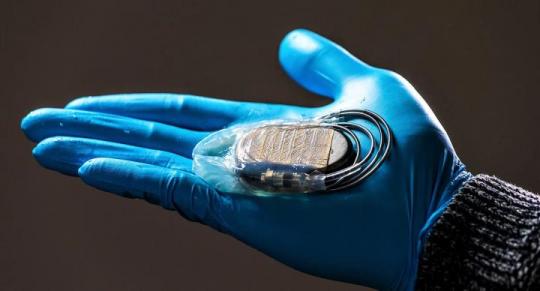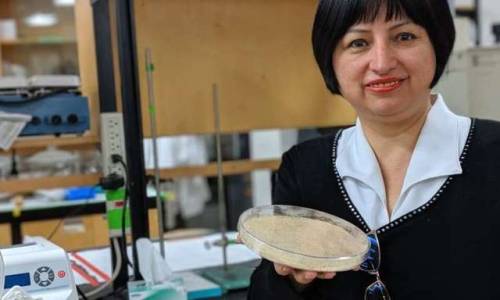#cellulose
Researcher uses canola to create biodegradable cling wrap
A University of Alberta researcher has found a new use for a canola byproduct, providing potential for diverse markets beyond China.
Canolastraw—the fibrous stalk left in the field after the plant is harvested for its oil—is proving useful in strengthening a plant-based cling wrap developed by Marleny Saldaña, a researcher in food and bioengineering processing.
In a new study, Saldaña and her research team used cellulose nanofibres from canolastraw to make the clear, plastic-like film, which is 12 times stronger than what they’ve already developed from cassava starch. The straw, which has little other use except as bedding for soil nutrients, contains cellulose and lignin, two components that support the canola plant.
Using canola straw this way demonstrates potential value-added options for the crop residue besides obtaining oil and protein from its seed, said Saldaña, who believes her and her team’s discovery to be the first application of its kind.
Post link

Above: A cellulose membrane for protecting pacemakers. Image credit: Hylomorph
By Anthony Caggiano
A cellulose membrane that can reduce the buildup of fibrotic tissue around cardiac pacemakers has been developed by ETH Zurich, Switzerland, scientists.
It could be used to help ease surgery when a pacemaker needs to be replaced.
Aldo Ferrari, a Senior Scientist in ETH Professor Dimos Poulikakos’s group and at research institute Empa, said if too much tissue has grown around a pacemaker – which usually has a lifespan of five years when its battery expires – it can be hard to remove the device in surgery. The surgeon may need to spend time cutting the tissue, and risk of infection may increase.
Ferrari and his colleagues at ETH Zurich have developed a membrane with a special surface structure that is less conducive to the growth of fibrotic tissue than the smooth metal surface of pacemakers.
This membrane has now been patented and Ferrari is working with fellow researchers at the Wyss Zurich research center, the University of Zurich and the German Center of Cardiovascular Research in Berlin to make it market-ready for use in patients.
To test the device, pigs were given two pacemakers - one enveloped in the cellulose membrane, one without. After a year of testing, the researchers found the pigs’ bodies did not reject the cellulose membrane.
‘This is an important finding because tolerance is a core requirement for implant materials,’ Ferrari said.
The fibrotic tissue that formed around the membrane was about a third of what grew around the unencapsulated pacemakers.
Two reasons have been identified as to why this may have happened. The first is because the material is fibrous by nature. Francesco Robotti, lead author of the study and a scientist in Professor Poulikakos’s group, explained further.
'When fibrotic tissue forms, the first stage is the deposition of proteins on the surface. A fibrous membrane surface impedes this process,’ he said.
The second factor is the researchers created the membrane with honeycomb-like indentations in the surface, each measuring 10 micrometres in diameter.
'These indentations make it difficult for the cells that form fibrotic tissue to adhere to the surface - the second stage in the formation processes,’ Robotti said.
The scientists want to apply for approval for clinical trials in humans in partnership with ETH spin-off Hylomorph, which will be responsible for commercialising the membrane. The trials are slated to start next year at three cardiac centres in Germany.
The findings were reported in Biomaterials.
The “Sonnet155″ by Lobke Beckfeld and Johanna Hehemeyer-Cürten,
The “Sonnett155″ is made from two different post-industrial waste materials – fruit skins left over from juice production and short cellulose fibres sourced from a local textile factory.
Although it resembles a purse or tote with swooping top handles, the product has a lifespan closer to a disposable paper bag and is designed to degrade naturally with wear before it can ultimately be composted or recycled.
Post link
Because of the gradual deterioration of body functions in the elderly, special attention should be paid to diet. So what should the elderly pay attention to in their diet? The elderly should pay attention to calcium supplementation, control the intake of salt, and eat more plant-based foods. Let’s take a look at some of the things that the elderly should pay attention to in their diet.
1.prevent obesity
The increase in blood pressure is directly proportional to obesity, and obese people have a high incidence of diabetes. Obesity promotes arteriosclerosis and becomes a cause of heart disease and stroke.
The cause of obesity is due to overeating, the intake of heat energy is more than the heat energy consumed, and the remaining part is transformed into fat accumulated in the body, accumulating day by day, and the chic and neat demeanor in middle-age has gradually become the image of staggering and pot belly.
To prevent obesity, first do not eat too much. The appetite in youth remains the same, but it becomes excessive in middle-aged and elderly people, because activities are reduced correspondingly when you get older, so it is more important to do as much activity as possible and consume excess heat in order to prolong your life.
2. Calcium supplement
Among the foods eaten daily, although the supply of calcium is sufficient in most cases, there are many other factors that affect calcium absorption in the food, such as excessive folic acid in plant leaf stems, and inappropriate calcium-phosphorus ratio; The main reason is that the function of the gastrointestinal tract of the elderly is reduced, and the absorption of calcium is correspondingly reduced. The amount of metabolic excretion does not decrease due to lack of absorption, but increases. It is often difficult for the elderly to heal fractures. Calcium deficiency is a very important factor. Therefore, it is important to increase calcium intake in the food of the elderly.
3. control salt intake
Many countries in the world advocate low-salt diets and try to reduce salt intake. Japan proposes that the appropriate intake of table salt is less than 10 grams. If the body is suitable, 1 gram of intake per day is enough to meet the requirements, but there is no taste when eating.
In the United States, the dietary salt is less than 5 grams. There is currently no standard in our country, but it is imperative to reduce the intake of salt, especially for northern residents who are “heavy” and prefer salty food, so attention should be paid. In fact, this problem should be noticed from the time the children eat, but it is more important for the elderly.
4. prevention of iron deficiency anemia
Since our diet is based on cereals, it is easy to cause insufficient iron supply in the body, and iron deficiency anemia may occur over time.
Especially female anemia is more pronounced, most of which are iron deficiency anemia. Anemia in young women, some people are due to keeping in shape and diet; and a considerable part of it is not eating well, coupled with physiological factors are more prone to anemia. Therefore, middle-aged and elderly people should pay more attention to this topic.
5. Eat more plant-based foods
Animal food contains less cellulose and high saturated fat content, which is not beneficial to the elderly, so the elderly should eat some plant-based foods. Increasing the intake of cellulose has certain significance for preventing constipation and intestinal tumors.
For more information,click here.







